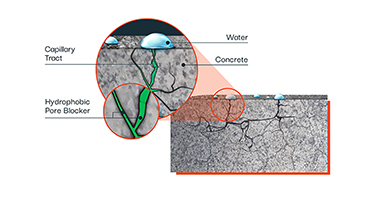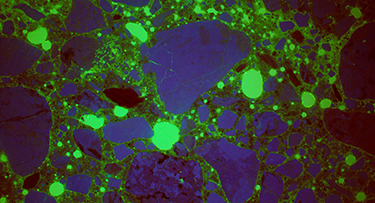|
Subscribe / Renew |
|
|
Contact Us |
|
| ► Subscribe to our Free Weekly Newsletter | |
| home | Welcome, sign in or click here to subscribe. | login |
Environment
| |
 |
April 25, 2024
Reducing embodied carbon in concrete construction
Hycrete

Montgomery
|
The construction industry’s use of concrete accounts for a huge percentage of the carbon emissions we generate as a society. Mostly, that’s due simply to the sheer amount of concrete we use. To put it into perspective, concrete is the second-most-consumed material in the world next only to water. As you can probably imagine, all of that material use comes with a whole lot of embodied carbon.
That’s why some of the major challenges today’s construction industry faces lie in finding new ways to make the building process more sustainable. How do we make construction cleaner, greener and more efficient? How do we make buildings that last longer and require less maintenance?
Obviously, any sustainability initiative has to include the raw materials being used — with concrete right at the top of the list. To that end, hydrophobic pore-blocking admixtures for concrete are one of the keys to minimizing the embodied carbon of the modern construction industry.
PUTTING EMBODIED CARBON INTO PERSPECTIVE
The built environment generates more than 40% of the annual carbon emissions in the United States. That places the construction industry (developers and builders of residential and commercial buildings, as well as infrastructure) amongst the highest producers of embodied carbon emissions by far.
As a whole, the construction sector is responsible for generating more embodied carbon than shipping, aviation or even electricity production. Which means on average, it will take 30 years before a building hits the same level of operational carbon emissions as the embodied carbon produced from constructing the building in the first place.
In the drive toward better sustainability across the industry, builders have employed a long list of strategies to minimize their carbon footprints while maximizing the lifetime of new construction. Hydrophobic admixtures are increasingly proving to be one of the best long-term solutions, as the first building material to achieve both Cradle to Cradle and NSF certification.
HOW HYDROPHOBIC PORE-BLOCKING TECHNOLOGY COMES INTO PLAY
Essentially, hydrophobic (water-repelling) liquid admixtures form a copolymer when mixed with concrete that fills in the material’s natural capillary system. The result is concrete that’s virtually non-porous, highly resistant to the transport of moisture vapor and liquid.?
Hydrophobic admixture technology all but eliminates the common concrete damage caused by freeze/thaw cycles — including cracks, delamination, and spalling. Likewise, it protects the structure’s internal steel reinforcement from long-term rust and corrosion.
WHAT ABOUT INSTALLED MEMBRANES?
Waterproof membranes which cover the exterior surfaces of below-grade concrete offer another way to protect against water incursion and corrosion. The problem is that the installation process is complicated and prone to inconsistency. Whether it’s a sheet membrane or liquid-applied membrane, the long-term effectiveness largely depends on how well it was installed. In comparison, hydrophobic pore blockers are electronically dosed directly into the concrete mix at the ready-mix plant.
Membrane installation is also heavily dependent on optimal weather conditions. As everyone in the industry knows, waiting around for the weather is one of the biggest causes of construction project delays. Other issues are that installing membranes requires a lot of intensive labor and wasted materials. More importantly, they make the concrete non-recyclable at the end of the building’s useful life — a huge cost in terms of overall carbon footprint.
Compared to waterproof membranes, hydrophobic admixtures make building weatherproof structures easier, more reliable, and more eco-friendly.
SEATTLE: LEADING THE CHARGE TOWARD BETTER SUSTAINABILITY
Seattle is one of the leading municipalities in the nation in terms of green initiatives that strive toward better sustainability. From the city’s extensive Sustainable Buildings and Sites Policy to its Green Building Policy and Priority Green Expedited program, Seattle encourages new construction to be more environmentally sound and sustainable. Rising to that challenge, builders throughout the region are increasingly harnessing hydrophobic admixture technology for more and more projects.
These Puget Sound projects used hydrophobic concrete admixtures in place of membrane systems:
• Bullitt Center
• Amazon
• Expedia
• Gates Foundation
• Microsoft
• King 5 Building
• Amtrak
• Seattle Aquarium
• Seattle Great Wheel
• UW Medicine
• Sound Transit
At the University of Washington Medical Center, hydrophobic admixtures were used for below-grade foundational protection.
The Expedia Group campus in Seattle also used hydrophobic admixtures for below-grade concrete construction, allowing them to get their parking garage slab placed sooner and avoid weather delays.
Various Amgen Parking facilities in the Seattle region also use concrete admixtures as long-term protection against water damage and corrosion and to eliminate the need for a membrane.
Vulcan Real Estate continues to develop in the South Lake Union area, despite the difficult waterproofing challenges of designing and building in high-water table conditions.
“We have incorporated hydrophobic concrete admixtures into numerous projects in the Seattle area and have found that it is a very effective approach to waterproofing, leveraging its advanced waterproofing benefits,” said Raymond Burdick, Director of Commercial Construction for Vulcan Real Estate. “Additionally, hydrophobic concrete admixtures contribute to LEED credits and significantly reduce the projects’ embodied carbon emissions by eliminating the necessity for membrane systems.”
The Google Lakefront Block projects with basements well below the level of Lake Union incorporated this approach.
Lindsey Montgomery leads business development for Hycrete’s US division focusing on education and strengthening client relationships.
Other Stories:
- Creativity and innovation are hallmarks of sustainability at PDX Airport
- Curbing construction’s carbon impact from all angles
- Making old buildings new again: the case for adaptive reuse
- Promoting residential adaptive reuse in Seattle through policy
- Hiding in Plain Sight: Sustainability and resilience beyond the terminal
- A blueprint for environmental responsibility in construction
- Old building, new tricks: Designing adaptive reuse for long-lasting relevance
- Harnessing the potential of mixed-use communities
- Implementing aggressive water goals
- Toward a path to zero carbon: building renovations and circular economy principles
- A primer on campus decarbonization in Washington




